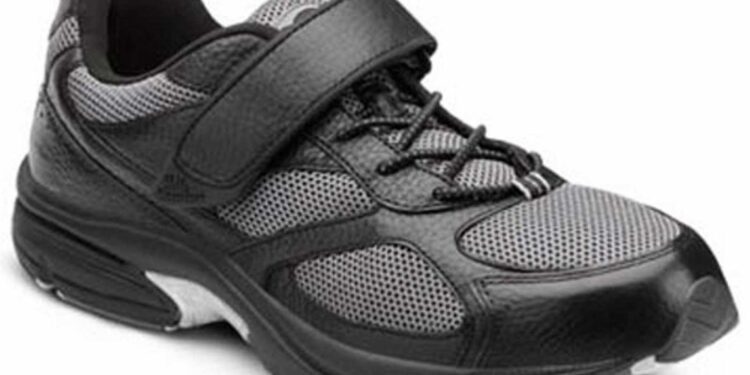Maintaining foot health in men with diabetes requires diligent attention and proactive measures, rather than just sporadic checks or a laid-back approach. For numerous individuals, complications from diabetes like neuropathy, inadequate circulation, ulcers, and pressure injuries present significant concerns. Conventional shoes frequently overlook the specific requirements of diabetic feet. A fresh wave of men’s diabetic shoes is transforming our perspective on foot health blending medical practicality, comfort, aesthetics, and cutting-edge design. In this post, we’ll explore how these innovations are reshaping expectations, the characteristics that define contemporary diabetic shoes, the latest trends, and how Fitville is adapting to this evolution in men’s footwear choices.
Why Diabetic Footwear Matters: The Stakes Are High
Individuals managing diabetes encounter challenges that extend far beyond mere inconvenience. Nerve damage, or neuropathy, can diminish the ability to feel pain, which may lead to unnoticed cuts or abrasions. Impaired circulation diminishes the ability of tissues to heal. What may seem like minor pressure or friction points for the average individual can actually serve as potential gateways for ulcers or infections. Consequently, footwear should take the initiative to minimize risk rather than simply respond to discomfort.
Medical guidelines for diabetic foot care consistently advocate for footwear that safeguards against pressure, shear, and microtrauma, while also accommodating deformities, swelling, and insensitivity. A thoughtfully crafted diabetic shoe serves as an integral component of a proactive approach, rather than just a comfort item.
In light of this context, how have men’s diabetic shoes developed over time and in what ways are they transforming our perspective on foot health?
Key Innovations That Make a Difference
Contemporary diabetic footwear is not merely a uniform design. Rather, it represents a fusion of various advancements in materials science, biomechanics, sensor technology, and medical feedback. Here are several of the most significant features:
1. Breathable, adaptive mesh and knit materials
Traditional diabetic shoes frequently featured rigid leathers or excessively cushioned uppers. The latest generation embraces innovative engineered meshes and stretch knits that effectively regulate heat and moisture while comfortably conforming to the contours of the foot. These fabric systems effectively minimize overheating, manage moisture, and provide localized expansion as required. These breathable materials effectively reduce the risk of fungal or bacterial issues in sensitive feet.
2. Seamless, low-profile interiors
One of the most significant risks for diabetic feet is the friction caused by interior seams or ridges. Numerous contemporary products feature entirely smooth linings or cushioned protective zones surrounding essential areas. This minimizes friction, lowers the chance of blisters, and prevents microtrauma in delicate areas like the toes, bunion spots, or metatarsal heads. In reviews of orthopedic and diabetic footwear, the importance of seamless interiors is frequently highlighted.
3. Extra depth and volume (especially in the forefoot)
Men’s diabetic shoes are now designed with enhanced vertical and horizontal space not only in length but also in width and depth to better accommodate swelling, deformities, or orthotic inserts. Innovative double-depth designs and spacious toe boxes alleviate pressure points, promoting natural foot movement without the discomfort of contact stress. Certain designs intentionally ease the overlays in the forefoot, allowing the shoe to accommodate natural expansion without restriction.
4. Removable footbeds and modular insole systems
Many diabetic shoes offer removable or adjustable footbeds to enhance the fit for individual needs. This allows users or clinicians to easily interchange personalized orthotic inserts, metatarsal pads, or off-loading components while maintaining the overall integrity of the shoe. The shoe’s outer layer needs to uphold sufficient structural strength while allowing for variations in inserts.
5. Shock absorption, energy return, and pressure distribution technologies
Due to the diminished sensitivity and circulation in diabetic feet, it is essential to prioritize cushioning and effective pressure distribution. A variety of footwear incorporates dual-density midsoles, gel or EVA cushioning, and comprehensive shock-absorbing layers to mitigate impact stress. Certain designs utilize pressure mapping during the development stage to guarantee that the internal geometry effectively disperses hotspots.
7. Style, aesthetics, and “non-medical” design
A significant hurdle to acceptance has been the unappealing “orthotic” appearance cumbersome, medical, and lacking in aesthetic appeal. Contemporary diabetic footwear features elegant designs, versatile styles, leather or blended materials, and a palette of neutral tones. Individuals can now enjoy the perfect blend of style and functionality. Reviews of fashionable diabetic footwear highlight the innovative reinterpretation of classic styles like oxfords, loafers, and sneakers, now designed with diabetic-friendly features.
Collectively, these advancements signify a transformation: diabetic shoes have evolved beyond mere medical apparatus; they now represent a blend of health, biomechanics, and practical everyday wear.
How These Innovations Translate to Foot Wellness
What do all these features accomplish aside from promotional assertions? The advantages reveal themselves in tangible forms:
Initially, we address the reduction of pressure peaks and shear forces. Delicate or vulnerable tissues tend to react unfavorably to repeated high stress, especially in areas situated over bony protrusions. The thoughtful cushioning, ample volume, and clever design of these shoes effectively alleviate stress transitions.
Secondly, enhanced microvascular well-being. Breathable uppers and a proper fit enhance temperature regulation and minimize moisture buildup crucial for lowering the risk of infection in sensitive skin.
Third, preserved or enhanced walking mechanics. Men’s diabetic shoes promote a more natural gait by allowing toes to spread, accommodating foot movement, and providing torsional stability, which in turn helps to minimize compensatory postural stress in the knees, hips, and back.
Fourth, timely identification and anticipatory measures. Intelligent sensor capabilities or offloading techniques can identify regions of increased temperature or pressure prior to the onset of ulcers. Instead of merely addressing injuries, these shoes could assist in averting them altogether.
Fifth, enhanced adherence. Comfortable and stylish footwear that minimizes discomfort encourages users to wear them consistently, providing reliable protection instead of occasional use.
In the end, these innovations transform diabetic footwear from merely a necessary remedy into a vital component of everyday foot care and sustained health.
Trends and Market Momentum
A number of significant trends are driving advancements in men’s diabetic footwear:
Demand is on the rise. The market for diabetic footwear is expected to expand from USD 8.45 billion in 2024 to USD 9.25 billion in 2025 and beyond, reflecting a compound annual growth rate of approximately 9.5%. The rise in consumer awareness, the aging demographic, and an increased focus on health are propelling this growth forward.
The rise of e-commerce is enhancing accessibility. Diabetic footwear used to be limited to specialized stores or clinics; however, the rise of online platforms now provides direct access, facilitating comparison, customization, and a wider selection. The growth drives rivalry and fosters creativity.
Customization and adaptable design are on the rise. With the increasing accessibility of scans, 3D footmodeling, and sensor data, the development of footwear that can adjust to individual foot shapes and walking styles is becoming increasingly practical.
The incorporation of health technology is increasingly gaining momentum. With advancements in sensorized insoles, AI offloading prescriptions, and connected footwear, we are on the brink of witnessing diabetic shoes that can actively monitor and respond in real time a significant breakthrough in foot wellness.
The blending of aesthetics persists. An increasing number of brands are introducing diabetic-friendly options for lifestyle footwear, including sneakers, casual boots, and dress styles, effectively bridging the divide between medical necessity and everyday fashion.
In this changing landscape, Fitville recognizes diabetic footwear as a fundamental aspect of foot health within the realm of men’s footwear, rather than a peripheral niche. Fitville is dedicated to curating and promoting top-notch diabetic models, catering to men who seek a blend of wellness and style.
How Fitville Integrates Diabetic Foot Welblness Into Its Offering
At Fitville, we aim to inspire men to embrace foot wellness while seamlessly blending style with contemporary comfort.
We evaluate options based on key factors smooth interiors, adaptable designs, orthotic-friendly features, cushioning, and flexibility in volume. We prefer designs that provide solid support in the heel and midfoot while also offering ample, accommodating areas in the forefoot.
We also offer educational opportunities. Many individuals who are not well-versed in diabetic footwear tend to think it refers to clunky, unattractive shoes. Fitville’s content seeks to dispel that misconception by showcasing stylish, modern designs that incorporate cutting-edge foot health innovations.
We keep a close eye on the latest technologies and sensor developments, carefully evaluating new smart footwear brands for their credibility before showcasing them. Whenever feasible, we collaborate with brands that integrate medical endorsements, positive test outcomes, and authentic user experiences.
Fitville aims to transform the narrative around diabetic footwear within men’s overall foot care. These shoes are not merely a necessity or a source of shame; rather, they represent a forward-thinking choice for enhancing mobility, ensuring comfort, and maintaining long-term foot health.
How to Choose the Right Men’s Diabetic Shoe: Fit & Evaluation Guidelines
No amount of advanced technology or branding can safeguard a foot if the shoe simply doesn’t fit well. Presented below are narrative-style guiding principles to assist in the evaluation of a diabetic shoe:
Start by establishing a firm heel lock this secures the foot, preventing any forward or lateral movement that could strain delicate areas. Next, examine the torsional rigidity in the midfoot: the footwear should effectively counteract any undesired twisting while walking or during abrupt motions. Examine the forefoot: the toes ought to spread gently when applying downward pressure, and there should be no discomfort or contact, even with minimal force. It’s best to try on shoes at the end of the day when your feet are at their fullest, and don’t forget to wear the socks you plan to use. Move with intention, adjusting your balance, transitioning smoothly from heel to toe, and if feasible, mimic the nuances of different terrains. Observe any regions of discomfort, sensations of tingling, or accumulation of heat.
Assess the removable footbed are you able to modify or add custom orthotics without compromising stability? Evaluate the cushioning response: the shoe must effectively absorb impact while maintaining its structure. Examine the inner seams and lining: lightly glide your fingers along the interior surfaces to identify any ridges or edges. Take into account breathability: in hotter environments or for those who tend to perspire, mesh or knit panels provide significant comfort.
It’s important to give diabetic shoes a chance to adjust to your feet. A gradual break-in period, involving a few hours of wear or short walks, can help them mold to your foot shape while minimizing any discomfort. Keep an eye out for any early indications of redness, discomfort, or blistering, and make adjustments as needed.
By following these evaluation steps, individuals can distinguish truly supportive men’s diabetic shoes from those that are simply marketed as such.
Future Directions: What’s Next in Diabetic Footwear
The future presents intriguing opportunities for diabetic footwear:
Innovative footwear designed to adjust its shape and stiffness in real-time, responding to the phases of walking and the pressure exerted by the foot.
Innovative pressure feedback systems that connect footwear to mobile applications or clinician dashboards, notifying users about hazardous areas.
Custom 3D printed shells tailored to individual foot scans, designed to match each user’s unique morphology.
Modular insert systems that enable precise adjustments for off-loading in specific areas (such as the forefoot and heel), adaptable for different days.
Innovative footwear that seamlessly combines athletic performance with diabetic-friendly features, ensuring that diabetic shoes look just as stylish as premium lifestyle options.
Algorithms and AI personalization are increasingly standard in prescription and design, fine-tuning every detail of shoe geometry to accommodate individual gait, weight, and foot sensitivity.
As these trends evolve, Fitville aims to stay ahead by curating, educating, and providing men’s diabetic footwear that promotes wellness and expands options.
In Summary
Men’s diabetic shoes have evolved beyond mere practicality; they are now refined tools for promoting foot health. With innovative materials that breathe and adapt, seamless interiors, cushioning, modular designs, and cutting-edge technologies, these shoes minimize risk, maintain natural biomechanics, and enhance everyday comfort.
For men managing diabetes, choosing the appropriate footwear can be an understated ally in maintaining health, shielding against harm, enhancing mobility, and upholding dignity. At Fitville, we hold the conviction that diabetic footwear deserves to be exceptional, not subpar. Our thoughtfully selected range of men’s diabetic shoes aims to enhance everyday comfort, blending medical expertise, ergonomic design, and fashionable appeal.













